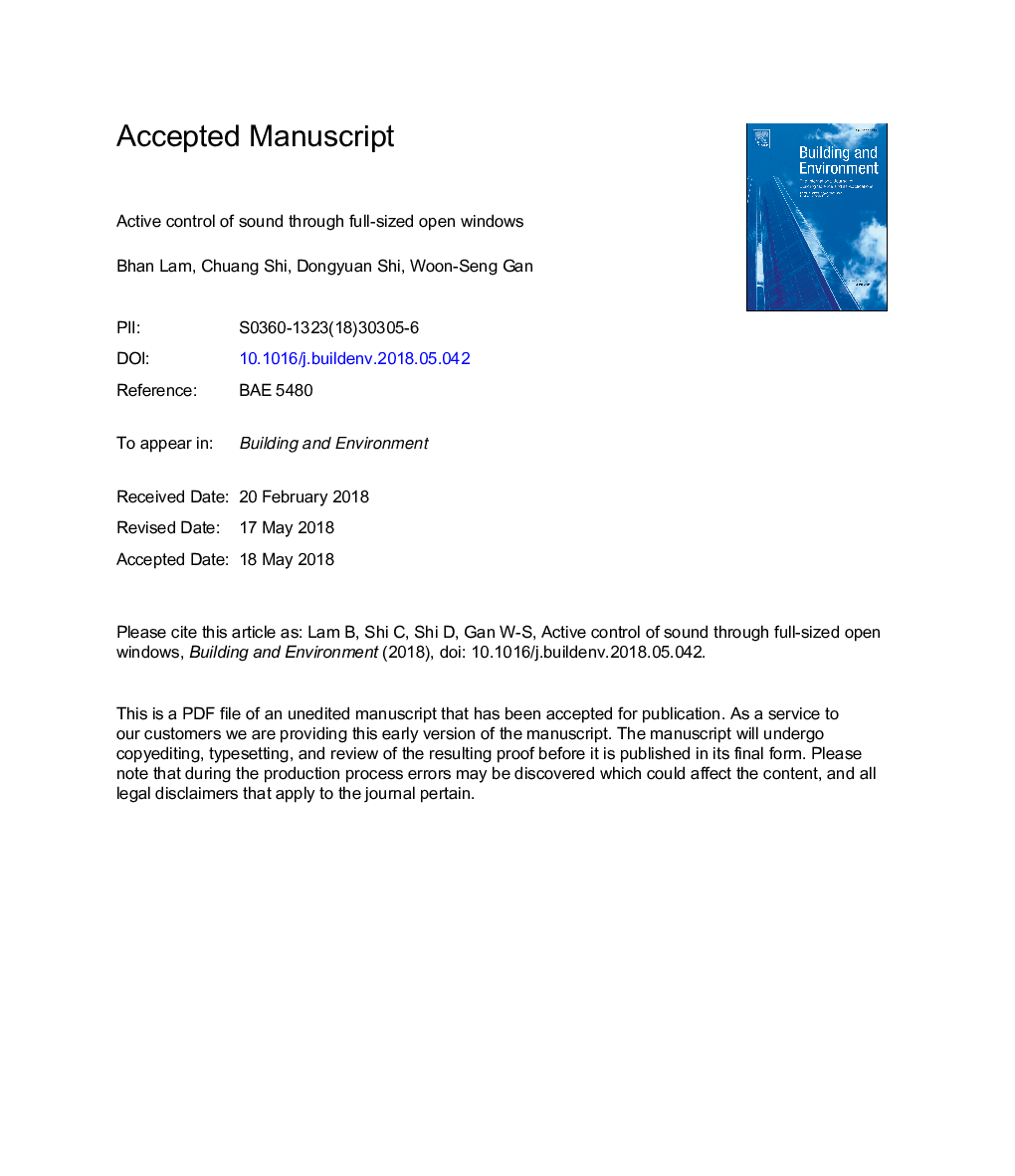| کد مقاله | کد نشریه | سال انتشار | مقاله انگلیسی | نسخه تمام متن |
|---|---|---|---|---|
| 6696892 | 1428351 | 2018 | 41 صفحه PDF | دانلود رایگان |
عنوان انگلیسی مقاله ISI
Active control of sound through full-sized open windows
ترجمه فارسی عنوان
کنترل فعال صدا از طریق پنجره های باز به اندازه کامل
دانلود مقاله + سفارش ترجمه
دانلود مقاله ISI انگلیسی
رایگان برای ایرانیان
کلمات کلیدی
کنترل نویز فعال، روش عنصر محدود رفع سر و صدا از طریق پنجره باز آکوستیک ساختمان
ترجمه چکیده
نیاز فوری برای رسیدگی به چالش های پایداری شهری افزایش دمای محیط و سطح سر و صدا در شهرهای پرجمعیت و بلند وجود دارد. راه حل هایی که از کنترل نویز فعال بر روی پنجره های باز استفاده می کنند تا سطح سر و صدای داخلی را افزایش دهند به نظر می رسد که تهویه طبیعی هنوز حفظ شده است. کنترل سر و صدای فعال با استفاده از مبدل های صوتی در اطراف پنجره باز ایجاد شده برای ایجاد سر و صدای ثانویه رخ می دهد که مخرب با سر و صدای واقعی مواجه می شود. دو روش رایج ترین ترتیب مبدل، طرح توزیع شده و مرزی، برای پنجره های کشویی معمولی تک لعاب مورد بررسی قرار گرفته است. روش عددی محدود برای ایجاد عملکرد کنترل سیستم کنترل نویز فعال و ضعف منفذ ارائه شده توسط پنجره کشویی استفاده می شود. بر اساس محدودیت های اساسی کنترل های فعال، طرح توزیع شده به طور مداوم عملکرد بهتر نسبت به طرح مرزی را به دست می دهد. روش طرح توزیع شده همچنین می تواند سر و صدا را به طور موثر تر از یک پنجره کاملا لرزان کاهش دهد. علاوه بر این، منابع توزیع شده تنها در باز شدن جزئی یک پنجره کشویی شبیه سازی شده می توانند نویز را به طور موثر به عنوان پنجره کاملا لمسی کاهش دهند. روش طرح توزیع شده بر روی یک پنجره کامل اندازه گیری شده است، جایی که سیستم کنترل فعال تا 16 کانال و به طور مساوی در سراسر پنجره باز می شود. در آزمون با صداهای تونال امکان سنجی سیستم کنترل فعال نمایش داده می شود. نتایج تجربی یافته های شبیه سازی شده برای امواج تابش طبیعی طبیعی را تایید کرده اند.
موضوعات مرتبط
مهندسی و علوم پایه
مهندسی انرژی
انرژی های تجدید پذیر، توسعه پایدار و محیط زیست
چکیده انگلیسی
There is a pressing need to address urban sustainability challenges of increasing ambient temperatures and noise levels in densely-populated, high-rise cities. Solutions that utilise active noise control on open windows to reduce indoor noise levels seem promising, as natural ventilation is still maintained. Active noise control utilizes acoustic transducers arranged around the open window to generate a secondary incidence noise that destructively interferes with the real noise. The two most common techniques of transducer arrangement, distributed and boundary layouts, are investigated for the typical single-glazed sliding window. Finite element method is used to establish the control performance of the active noise control system and the passive attenuation provided by the sliding window. Based on the investigated fundamental limits of active control, the distributed layout has consistently yielded better performance than the boundary layout. The distributed-layout method can also reduce noise more effectively than a fully-glazed window. Moreover, sources distributed only in the partial opening of a simulated sliding window can attenuate noise as effectively as the fully-glazed window. The distributed-layout method is tested on a full-sized window, where the active control system has up to 16 channels and evenly distributed across the window opening. In the test with tonal sounds, the feasibility of the active control system is demonstrated. The experimental results have validated the simulation findings for normal incidence plane waves.
ناشر
Database: Elsevier - ScienceDirect (ساینس دایرکت)
Journal: Building and Environment - Volume 141, 15 August 2018, Pages 16-27
Journal: Building and Environment - Volume 141, 15 August 2018, Pages 16-27
نویسندگان
Bhan Lam, Chuang Shi, Dongyuan Shi, Woon-Seng Gan,
